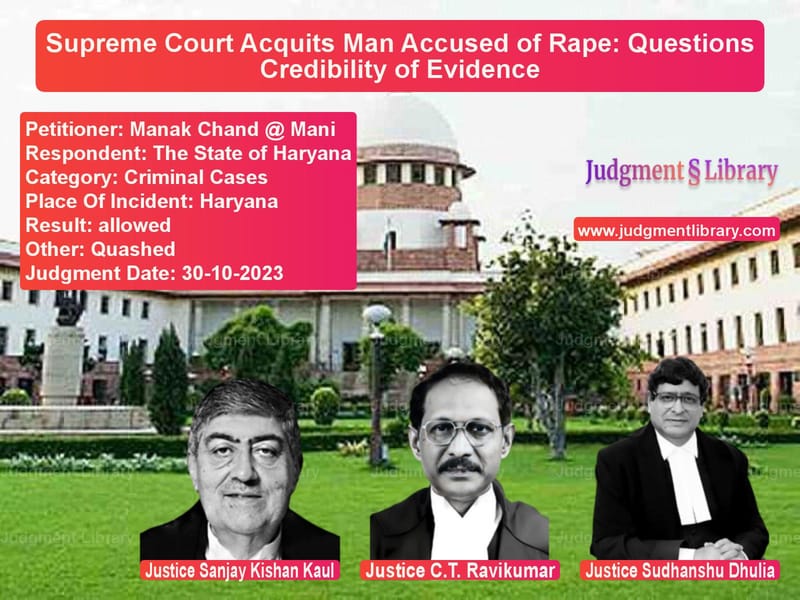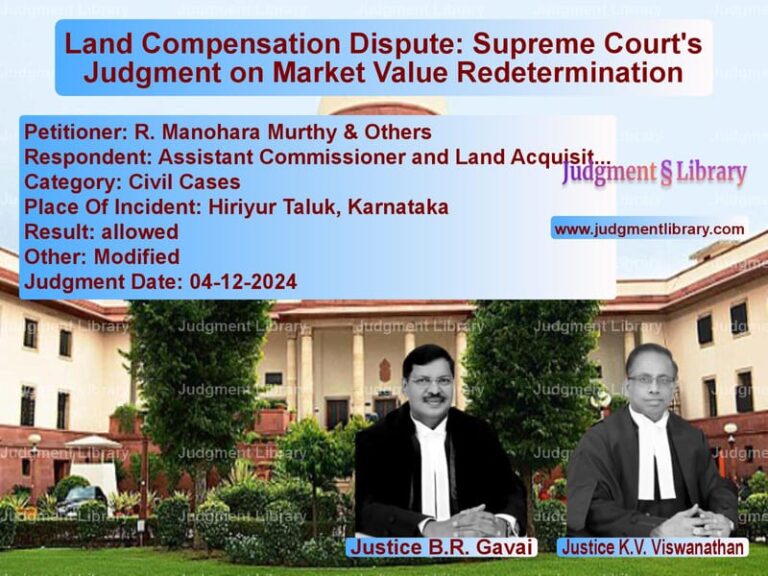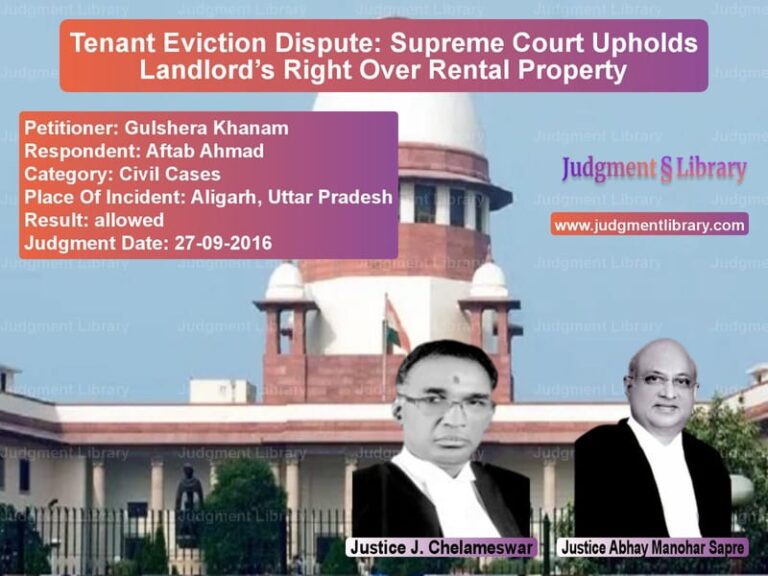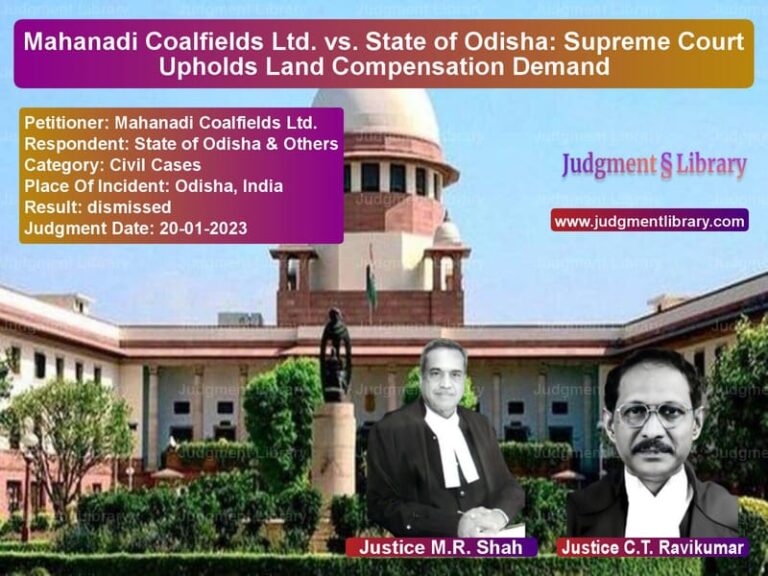Supreme Court Acquits Man Accused of Rape: Questions Credibility of Evidence
The case of Manak Chand @ Mani v. The State of Haryana revolves around the conviction of the appellant under Section 376 of the Indian Penal Code (IPC) for allegedly raping a minor. The Supreme Court, upon reviewing the inconsistencies in the prosecution’s case, ruled that the evidence was insufficient to sustain the conviction and consequently acquitted the appellant.
Background of the Case
The appellant, Manak Chand @ Mani, was convicted by the Trial Court for raping a minor and was sentenced to seven years of rigorous imprisonment along with a fine. The Punjab and Haryana High Court upheld this conviction. However, upon appeal, the Supreme Court re-examined the evidence and found significant gaps in the prosecution’s case.
The prosecution alleged that the appellant raped the prosecutrix multiple times while she was staying at her sister’s matrimonial home. The prosecutrix, allegedly 15 years old at the time, initially remained silent and only disclosed the incidents to her mother upon returning home after more than a month. An FIR was filed after marriage negotiations between the families failed.
Key Evidence and Findings
1. Age Determination of the Prosecutrix
The prosecution claimed that the prosecutrix was a minor, making any sexual act with her legally non-consensual. The school register recorded her date of birth as April 4, 1987, which would make her 13½ years old at the time of the incident. However, the Supreme Court found several issues with this evidence:
- The prosecution did not produce the original transfer certificate, which was the basis for the date of birth recorded in the school register.
- The school register, which recorded her attendance, showed that she was present in school on the day she claimed she was raped at her sister’s home, casting doubt on her version of events.
- The medical examination suggested she was around 16 years old, and her mother also stated that she was 16 at the time of the incident.
- No bone ossification test was conducted, which could have provided a more reliable determination of her age.
2. Delay in Reporting the Alleged Rape
The prosecutrix alleged that the first incident of rape occurred on September 12, 2000, followed by two or three more incidents. However, she did not disclose the alleged crime immediately. The Supreme Court found the delay significant:
“Although the first incident of rape is alleged to be of 12.09.2000, the prosecutrix does not disclose this to anyone immediately. She then alleges rape again on two or three different occasions later, though no date and time are disclosed. She only discloses it to her mother after one and a half months.”
The Court further noted that the FIR was filed only after marriage negotiations between the families failed, raising questions about the motive behind the complaint.
3. Medical Examination Report
The medical examination of the prosecutrix was conducted by Dr. Kulwinder Kaur on October 28, 2000. The report stated:
- There were no external marks of injury on her body.
- The prosecutrix had well-developed secondary sexual characteristics.
- Her hymen was ruptured, but she was described as “habitual to sexual intercourse.”
- The report explicitly stated that no force seemed to have been used against her.
The Supreme Court observed:
“At the time of medical examination of the patient, no force seems to have been used against her. The patient was habitual to sexual intercourse because her labia minora was hypertrophied and hymen admitted two fingers.”
Supreme Court’s Observations
The Supreme Court emphasized that while the testimony of a rape survivor should be taken seriously, courts must also ensure fairness to the accused:
“A false allegation of rape can cause equal distress, humiliation, and damage to the accused as well. The accused must also be protected against the possibility of false implication.”
The Court reiterated that if the testimony of the prosecutrix does not inspire confidence, the court must look for corroborative evidence:
“The broad principle is that an injured witness was present at the time when the incident happened and that ordinarily such a witness would not tell a lie as to the actual assailants, but there is no presumption or any basis for assuming that the statement of such a witness is always correct.”
Read also: https://judgmentlibrary.com/criminal-case-dismissed-supreme-court-overturns-section-319-crpc-order/
Final Judgment
After reviewing all aspects of the case, the Supreme Court concluded:
“The prosecution has not successfully proven that the prosecutrix was less than sixteen years of age at the time of the alleged commission of the crime, and therefore the benefit ought to have been given to the appellant. Moreover, as to the factum of rape itself, we are not convinced that an offence of rape is made out in this case as it does not meet the ingredients of Rape as defined under Section 375 of the IPC.”
The Court set aside the convictions from both the Trial Court and the High Court and acquitted the appellant.
Implications of the Judgment
This judgment reinforces the principles of fair trial and due process in criminal cases. Key takeaways include:
- Reliable age determination is crucial in cases involving allegations of rape involving minors.
- Delay in reporting an alleged crime raises serious questions about credibility.
- Medical evidence must support the allegations beyond a reasonable doubt.
- While courts must ensure justice for victims of sexual crimes, they must also protect the rights of the accused to prevent wrongful convictions.
The Supreme Court’s ruling serves as a precedent that underscores the need for thorough and fair examination of evidence before convicting an individual accused of a serious offence like rape.
Petitioner Name: Manak Chand @ Mani.Respondent Name: The State of Haryana.Judgment By: Justice Sanjay Kishan Kaul, Justice C.T. Ravikumar, Justice Sudhanshu Dhulia.Place Of Incident: Haryana.Judgment Date: 30-10-2023.
Don’t miss out on the full details! Download the complete judgment in PDF format below and gain valuable insights instantly!
Download Judgment: manak-chand-@-mani-vs-the-state-of-haryana-supreme-court-of-india-judgment-dated-30-10-2023.pdf
Directly Download Judgment: Directly download this Judgment
See all petitions in Rape Cases
See all petitions in Bail and Anticipatory Bail
See all petitions in Judgment by Sanjay Kishan Kaul
See all petitions in Judgment by C.T. Ravikumar
See all petitions in Judgment by Sudhanshu Dhulia
See all petitions in allowed
See all petitions in Quashed
See all petitions in supreme court of India judgments October 2023
See all petitions in 2023 judgments
See all posts in Criminal Cases Category
See all allowed petitions in Criminal Cases Category
See all Dismissed petitions in Criminal Cases Category
See all partially allowed petitions in Criminal Cases Category







